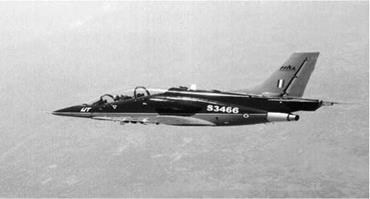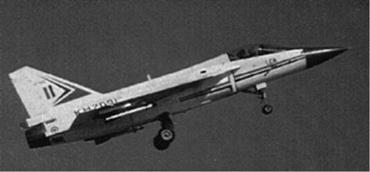SALIENT FEATURES OF CERTAIN AIRPLANES
SARAS aircraft (Figure A12), designed and developed by National Aerospace Laboratories, India, is a multirole light transport aircraft ideal for executive travel, air-ambulance, and surveillance. It is an unconventional configuration with clean wing and pusher propellers on aircraft fuselage mounted turboprop engines and is capable of operating from semiprepared and high-altitude runways. It has a T-tail with delta-shaped vertical fins to provide pitch recovery at high AOAs. A single slotted fowler flap is provided to meet the takeoff and landing requirements. Powered with P&WC PT6A-67A turboprop engine, it has a maximum cruise speed of 550 km/h. At present, with two prototypes flying, flight testing is underway to meet FAR-25 airworthiness standards.
HJT-36 (Figure A13) is an Intermediate Jet Trainer (IJT) aircraft under development by Hindustan Aeronautics Limited (HAL) for the Indian Air Force. It is slated to replace the aging HJT-16 Kiran aircraft, which is currently used by the Indian Air Force. It has a conventional jet trainer design, with a low, swept wing, staggered cockpits, and small air intakes on either side of its fuselage. It has manually operated flight controls with three-axes trim capability using electrical actuators. With an overall length of 11.0 m, a service ceiling of 9 km, and a
|
|
|
FIGURE A14 HANSA two-seater aircraft. |
maximum takeoff weight of 4500 kg, the aircraft can achieve a maximum Mach number of 0.75.
HANSA-3 aircraft (Figure A14), designed by National Aerospace Laboratories of India, is an all-composite light trainer aircraft ideal for training, sport, and hobbyflying. It is certified under FAR-23 and is successfully flying in various flying clubs of India. Its main features include a neat cockpit with good visibility, dual controls, and turbo charged engines with a constant speed propeller. It has an overall length of
7.6 m, wing span of 10.47 m, and all-up weight of 750 kg with usable fuel capacity of 85 L. It has a maximum cruise speed of 96 knots.
Aircraft Tejas (Light Combat Aircraft – LCA; Figure A15) is designed and developed by Aeronautical Development Agency (ADA), India, with an aim to replace the aging MiG-21 aircraft as the Indian Air Force’s primary multirole tactical aircraft. It is a single engine tail-less delta wing aircraft designed to be aerodynamically unstable in the longitudinal axis. The wing supports three-segment leading edge slats
|
|
and two-segment elevons that span the entire length of the trailing edge. The elevons are the primary control surfaces in pitch and roll. In order to stabilize the airframe and achieve the desired performance over the entire flight envelope, it incorporates a quad redundant full authority fly by wire (FBW) flight-control system (FCS). Its takeoff weight is around 8500 kg and has a maximum speed of 1.8 Mach.














